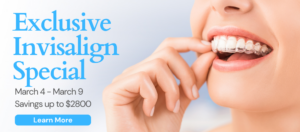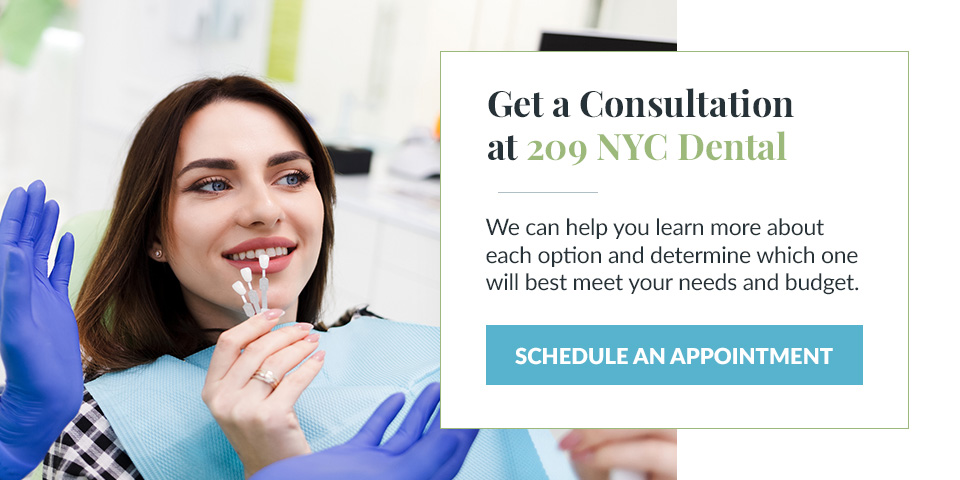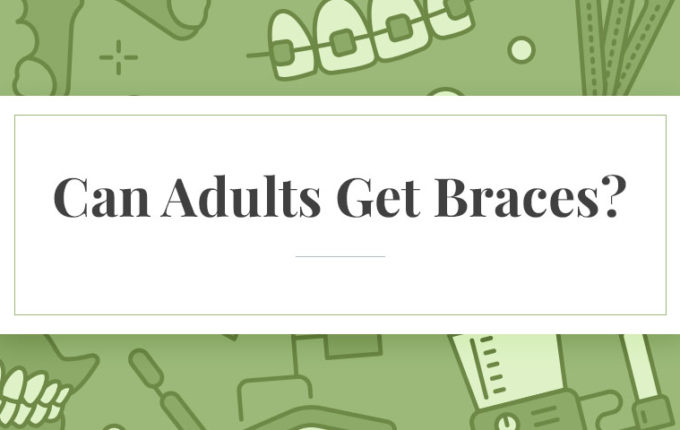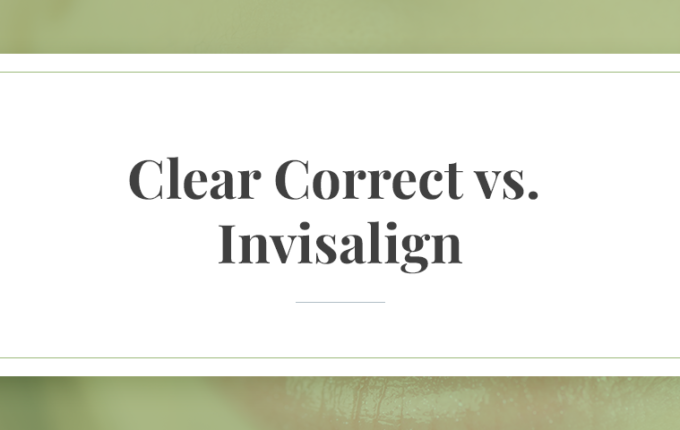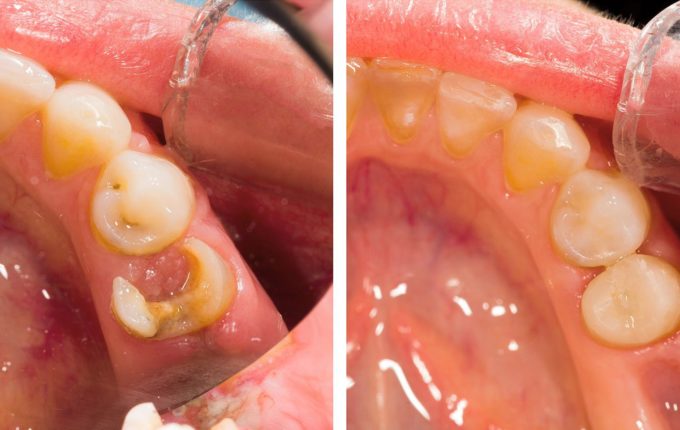Invisalign vs. Veneers
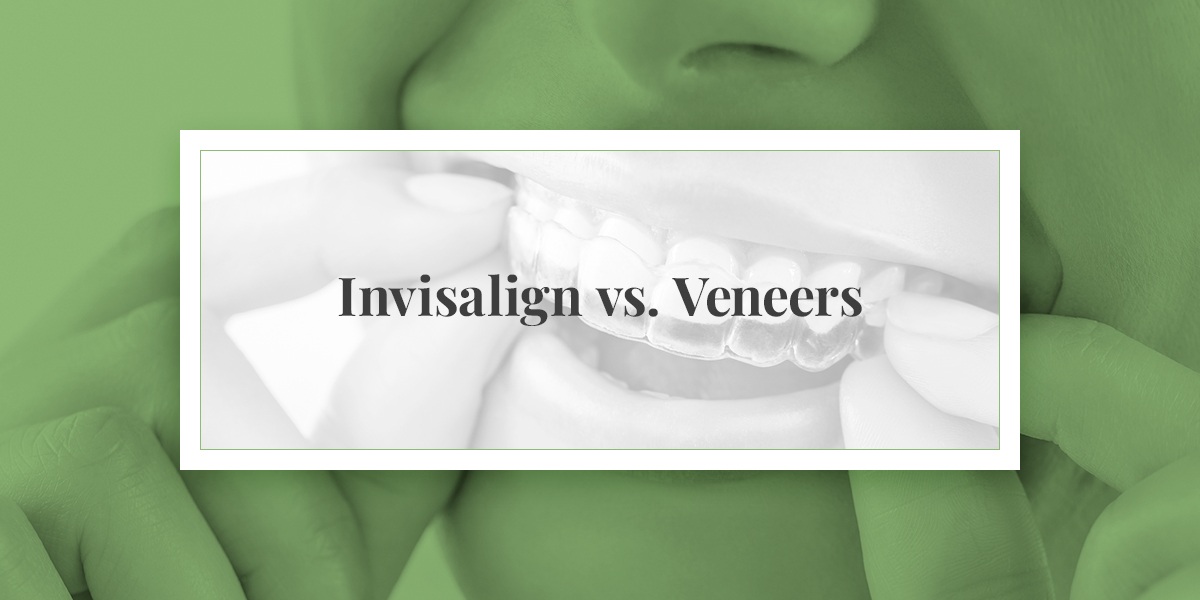
If you feel self-conscious about your smile, there are ways to fix it. Both Invisalign and veneers can help you correct and improve the appearance of your teeth, but each one does so differently. Invisalign vs. veneers is a common question asked by our patients. Deciding which option is right for you all depends on the current state of your teeth and your goals when it comes to your smile.
Learn more about each treatment option — including how they’re alike and different — so you can make the right choice for your smile.
- Invisalign in NYC
- Pros of Invisalign
- Cons of Invisalign
- The Ideal Candidate for Invisalign
- Veneers in NYC
- Pros of Veneers
- Cons of Veneers
- The Ideal Candidate for Veneers
- Invisalign vs. Veneers: The Big Differences
Invisalign in NYC

Over 14 million people have used Invisalign to straighten their teeth and improve their smile’s appearance. An alternative to traditional bracket braces, Invisalign uses clear trays to help rectify the teeth. The treatment can help to correct a range of concerns in the mouth, including:
- An overbite, when the upper teeth significantly protrude
- An underbite, when the lower arch protrudes beyond the upper arch
- Gaps or spaces between teeth
- Crowded or overlapped teeth
- An open bite, when the teeth don’t meet when the mouth is closed
The clear trays you wear during Invisalign are custom-made for your mouth and teeth. So, they will apply pressure and force to the teeth just the right way, whether your teeth need to be rotated, pushed or shifted horizontally. Most patients switch to a new set of aligners weekly, so their teeth slowly move into the new, more aligned position.
The length of Invisalign treatment largely depends on you, the patient. The average length of the treatment is between six and twelve months. Still, various factors can affect the duration, including how your teeth are positioned at the start of treatment and how well you comply with instructions.
Pros of Invisalign
Invisalign offers several benefits to people hoping to straighten their teeth or otherwise improve the appearance of their smile. Those benefits include:
- Nearly invisible treatment: You might not want people to know you’re getting treatment to correct your teeth. The clear trays used with Invisalign mean no one has to know you’re wearing them unless you decide to reveal that information.
- Removable trays: With traditional metal braces, there is no way to take them off until the end of treatment. This can create challenges regarding oral hygiene since the food can easily get trapped in your braces. With Invisalign, patients can remove the trays when eating or brushing their teeth and flossing, making it easier to maintain oral hygiene.
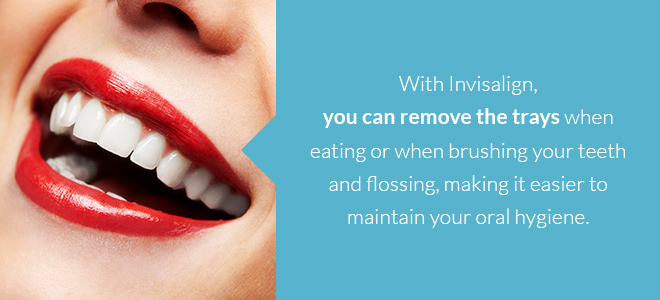
- No food restrictions: People who wear traditional braces are often given a long list of foods to avoid, as they can get stuck in the braces. That is not the case with Invisalign. There are no restrictions on what you can eat and when you want to eat.
- Improved comfort: Metal braces can poke the insides of your cheeks or cause irritation to the gums. Invisalign aligners are made from a smooth plastic that doesn’t poke or chafe.
- Safe materials: The material used to make Invisalign trays is BPA-free medical-grade plastic that does not contain other harmful toxins, so you can feel confident about putting the trays in your mouth.
- Faster than traditional braces: The average treatment period for Invisalign is about 12 months, which is half the time required for traditional braces (24 months).
Cons of Invisalign
Although Invisalign has many benefits, it is not without its drawbacks. When you are considering Invisalign, it is essential to understand what the disadvantages of the treatment are or can be, including:
- Getting used to the aligners: Although the clear plastic aligners are usually comfortable, there can be a period of adjustment, especially when you first start wearing them. It might take a few days before the aligners feel natural in your mouth. Sometimes, wearing the aligners over the teeth can cause people to develop a slight lisp.
- Wearing the aligners as directed: In the end, the success of your Invisalign treatment largely depends on you. You will need to wear the aligners for 22 hours every day. Some people forget to wear their aligners for the recommended amount of time and do not see the progress they had anticipated. Not wearing the aligners as directed can interfere with your treatment in a few ways. If you do not wear them enough, your teeth might not fit into the aligners during treatment. Treatment time may need to be extended< when people do not follow the instructions given to them.
- Cleaning your teeth more frequently: Keeping your teeth clean is essential when undergoing Invisalign. It’s recommended that you brush your teeth after each meal or after eating or drinking anything that’s not water. While keeping a toothbrush and toothpaste handy can be an added burden, it can also improve your oral health and the appearance of your smile.
- Dealing with loose aligners: Since the aligners are not attached to your teeth — and you’re meant to remove them when eating or drinking — there is the chance that you will misplace them.
- Paying for the cost: The average cost for Invisalign is $5000 nationwide, which is the same as the cost of traditional orthodontic treatment. In New York, the average cost is $6500. It is possible to find prices that are lower than average, though. For example, we offer Invisalign for $5,950. Check out Invisalign Special for more details.
The Ideal Candidate for Invisalign
Invisalign is not the right treatment for everyone. The treatment is best suited for adult patients rather than children. Children who do not have all of their permanent teeth yet are not ideal candidates for the treatment.
People who are suitable candidates for Invisalign should expect to become fully committed to the treatment and able to follow the recommended instructions from the dentist. That includes changing the aligners as advised and seeing a dentist for check-ups every six weeks or so. A patient should understand what to expect during the treatment, including how many in-office visits are required to start Invisalign and how long they will need to wear the aligners.
Additionally, it’s important to note that Invisalign cannot treat every issue with the teeth. The aligners can help to straighten teeth and close gaps between the teeth, as well as help correct crowding. The treatment can also adjust certain types of bites, like overbite and underbite. But people with severe cases of malocclusion or with teeth that are severely misaligned might not be candidates.
Veneers in NYC
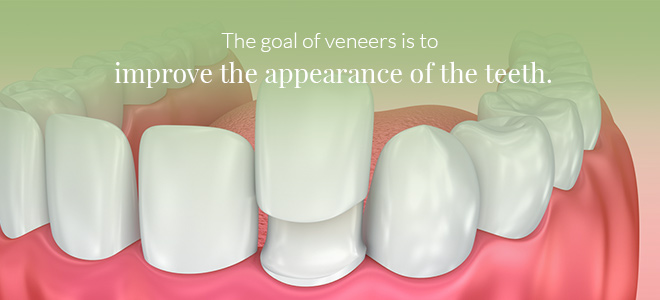
Veneers are thin sheets of porcelain that adhere to the front of the teeth. The goal of veneers is to improve the appearance of the teeth. They can do so by changing the color of the teeth, covering up cracks or chips or smoothing a tooth’s surface. Veneers can also help to close spaces or gaps between the teeth and change the size of the teeth.
The process of receiving veneers requires a few trips to the dentist’s office. Since the veneers take up space on the teeth, the first step is to file down the front of the treated teeth to make room for the veneer. Then, the dentist will take an impression of the teeth using either a traditional mold and putty or 3-D imaging.
A lab uses the impression to create the veneers, which are custom fit for every patient. While a patient waits for the permanent veneers to be made, the dentist will give them a temporary cover to wear.
Pros of Veneers
Porcelain veneers offer several benefits to patients who decide to receive them, including:
- Solving multiple dental issues: As a cosmetic treatment, veneers can treat a variety of concerns. For example, they can whiten your teeth, cover up a gap or space or cover up a cracked or chipped tooth.
- Offering a long life span: Veneers aren’t necessarily permanent, but with the right care and treatment, you can expect them to last for a long time. The average porcelain veneer can last for up to 15 years.

- Protecting eroded teeth: The enamel that covers your teeth helps protect them, but enamel can erode for various reasons. A veneer can help to restore eroded teeth and protect others from further erosion.
- Improving your confidence: Whether by whitening your teeth or correcting a chip, crack or other issue, veneers can improve the appearance of your smile, giving you a boost of confidence.
Cons of Veneers
Porcelain veneers might have many benefits, but they are not perfect. A few drawbacks to veneers include:
- They’re only a cosmetic treatment: Porcelain veneers are meant to improve the appearance of your teeth. They will not correct any underlying issues with the teeth, such as an overbite, an underbite or cavities.
- Their color remains the same: Your teeth naturally change color over time based on your diet and other causes. Porcelain veneers stay the same, though. That can be fine if you have veneers over each one of your teeth. However, if you only have one or a few veneers, the difference in color between them and your natural teeth can become very noticeable.
- They do not last forever: Although veneers do have a long life with proper care, they are not meant to last for the rest of your life. You will most likely need to pay for replacement veneers at some point.
- It’s possible for them to chip or crack: Porcelain is both a hard and breakable material. There’s a risk that your veneers will chip or crack, especially if you bite your nails, grind your teeth or chew ice or other hard foods.
- They are irreversible: Since getting veneers involves filing down the tooth surface, once you get them, the procedure cannot be reversed unless you agree to get the tooth replaced.
The Ideal Candidate for Veneers
The ideal candidate for veneers is a person with healthy or not significantly compromised teeth who wants to improve the appearance of their smile. Veneers are recommended for adults. Because the veneer attaches to the front of the tooth, the tooth must be full-sized before placement.
Invisalign vs. Veneers: The Big Differences
When deciding between veneers vs. Invisalign, the critical thing to remember is your primary goal. Both treatments can improve the look of your smile, but Invisalign focuses on correcting your bite and the alignment of your teeth. Meanwhile, veneers correct cosmetic issues, such as the color, shape, texture and size of your teeth.
Let’s take a closer look at five significant differences between veneers and Invisalign.
1. Cost
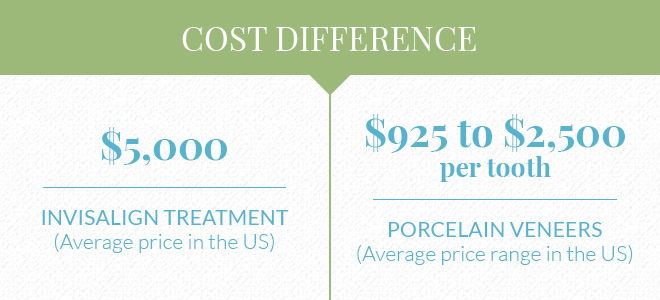
At first glance, it can seem that veneers are the winner when it comes to the cost — the average Invisalign treatment costs $5000. Meanwhile, porcelain veneers typically cost between $925 and $2500 per tooth. If you are having only one tooth corrected with a veneer, it can be the less expensive option — at least initially.
However, many people need more than one veneer, which increases the cost considerably. It’s also worth remembering that you will most likely need to replace your veneers at some point in the future, which can add to the cost.
2. Treatment Length
Another thing to consider when weighing the differences between veneers and Invisalign is how long the treatment takes. Invisalign typically requires a greater time commitment, as you must see the dentist for the initial consultation, then return for a second treatment, during which the dentist takes a before picture of your mouth, does initial scans — or takes impressions if they don’t have an iTero 3D scanner — and puts together a treatment plan. After that, you will most likely return to see your dentist for regular check-ups.
If you follow the plan and the instructions given to you, the entire treatment process typically takes 12 months.
The process of receiving veneers only requires two visits to the dentist plus the initial consultation. During the first operative visit, the dentist will prepare your teeth, take the impression and fabricate beautiful temporary veneers. When the veneers are created and ready, you will go in for another appointment.
During the second visit, the dentist will remove the temporary veneers, adhere the permanent ones to your teeth and check your bite to ensure you are comfortable. You will want to see your dentist regularly for routine exams and cleanings and to monitor the condition of the veneers.
3. Current Dental Health
The current state of your oral health can influence whether veneers or Invisalign is the right choice for you. Both treatments require you to be in good health, both in terms of your teeth and gums, since neither treatment will correct issues such as gum disease or cavities. If you have cavities or another dental health issue, your dentist will most likely recommend treating it before considering veneers or Invisalign.

4. Treatment Goals
The most significant difference between veneers and Invisalign is the goal of the treatment. You would likely choose veneers if you want to whiten your teeth or correct a chip or crack. If you wish to correct an overbite or underbite, Invisalign is the more appropriate choice.
There is some overlap when it comes to the two treatment options. For example, if you have a gap between two teeth, Invisalign can help to close it, or veneers can help to conceal the gap. We recommend proceeding with Invisalign if you have healthy teeth since tooth alignment is the only issue. However, if you have old fillings or stained teeth, then porcelain veneers might be a better option.
The image below shows ideal examples of the treatment goals of Invisalign and veneers. On the left, Invisalign shows an aligned tooth structure, including a corrected overbite, through its treatments. The veneer before and after on the right displays a whiter smile through cosmetic adjustments.
Commonly Asked Questions
Over the years, we have gotten the following questions from several patients regarding certain requirements for either veneers or Invisalign. Feel free to reach out to us with any other questions that are not addressed below. We look forward to helping in any way we can.
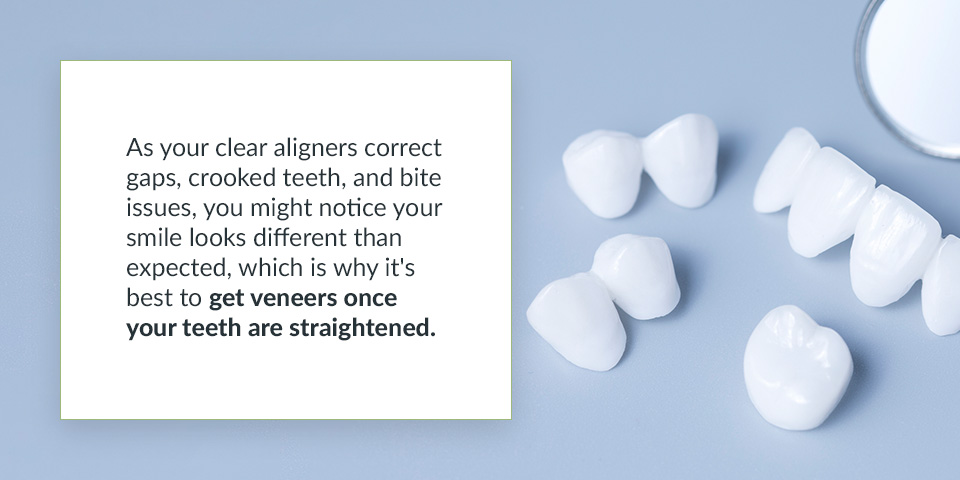
Do You Need Straight Teeth for Veneers?
Your teeth do not need to be perfectly straight to get veneers — however, veneers can look more natural with straight teeth.
As you may already know, crooked teeth that are pushed together have a higher likelihood of breaking, chipping or causing other oral health complications. Porcelain veneers are done as a cosmetic procedure, meaning they will only cover a problem rather than fix it at the root. In other words, porcelain veneers may look odd or out of place with crooked teeth.
On the other hand, a slight misalignment is not a big deal, but be sure to consult with your dentist to see if veneers can work effectively for you.
Can I Get Invisalign When I Have Porcelain Veneers?
You can get Invisalign even with veneers, but it’s best to get veneers installed after your Invisalign treatment. It’s important to address why you want to get Invisalign if you already have veneers. Are you unhappy with the size or shape of your teeth? Do you feel like your veneers have been ineffective at addressing these issues?
As your clear aligners gradually correct gaps, crooked teeth and bite issues, your smile might look different than expected. If you have gotten veneers to mask crooked teeth, then getting them straightened now will entirely change the presentation of your veneers. Getting Invisalign involves a risk of the veneers looking too large or otherwise inappropriate once your teeth are aligned. This might mean you will want your veneers replaced, so it’s best to get them once your teeth are straightened.
Invisalign can only straighten teeth without altering their shape. Other cosmetic dentistry treatment options are available if you’re unhappy with your veneers.
Get a Consultation for New Veneers or Invisalign
At 209 NYC Dental, we offer both veneer and Invisalign treatment options. A consultation with one of our dentists can help you learn more about each option and determine which will best meet your needs and budget. Contact us today or call us at 212-355-2290 to schedule your appointment.
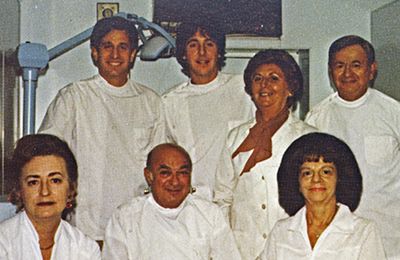 Our History
Our History
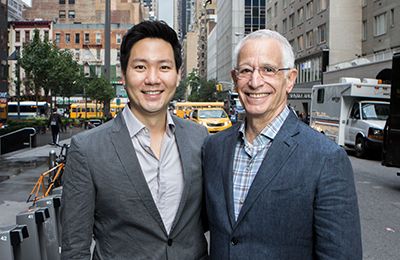 Our Providers
Our Providers
 About Us
About Us
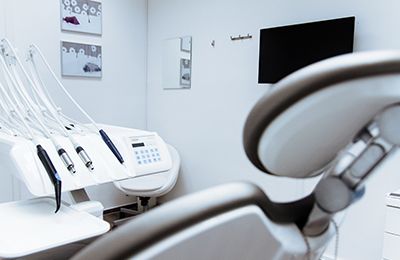 Blog
Blog
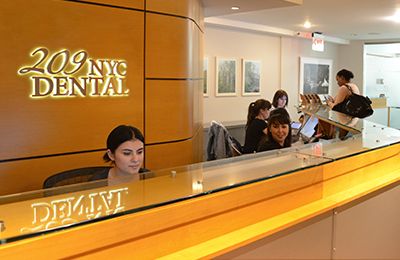 Contact us
Contact us
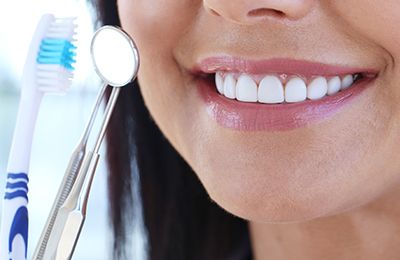 Diagnostic & Preventive
Diagnostic & Preventive
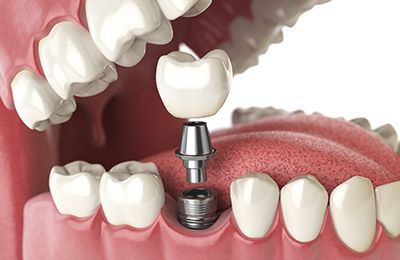 Implant Dentistry
Implant Dentistry
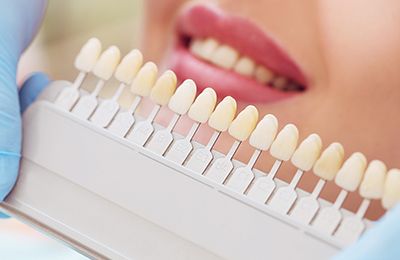 Cosmetic Dentistry
Cosmetic Dentistry
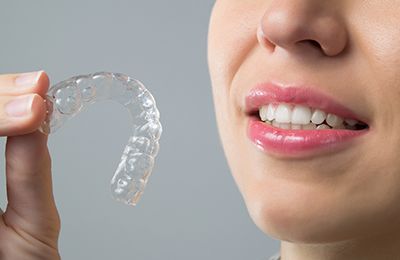 Clear Braces
Clear Braces
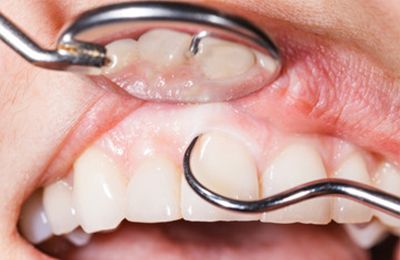 Periodontics
Periodontics
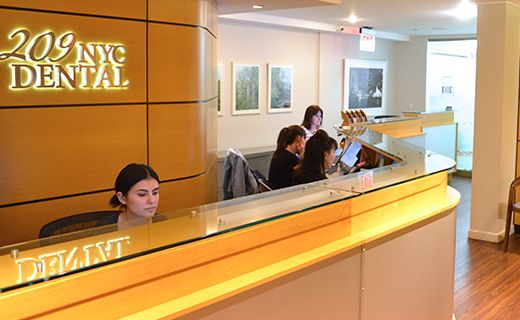 Patient Forms
Patient Forms
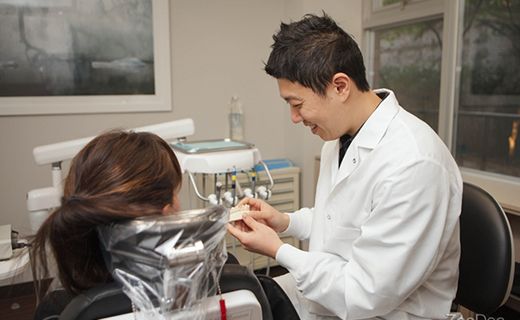 Payment Information
Payment Information
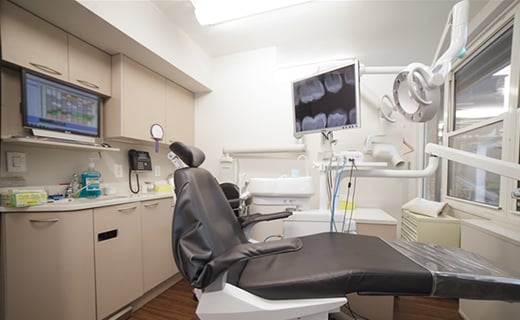 Insurance Options
Insurance Options
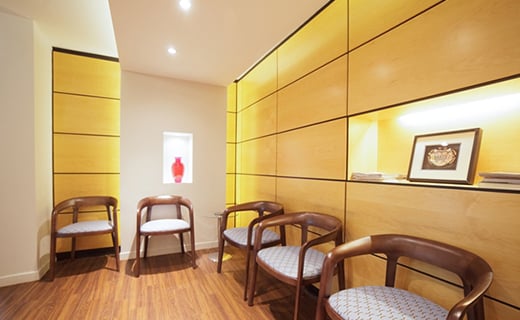 CareCredit Dental
CareCredit Dental
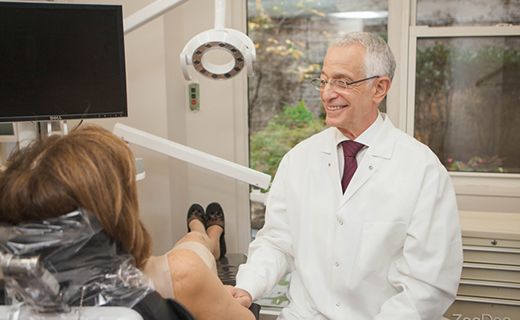 Appointment Policy
Appointment Policy
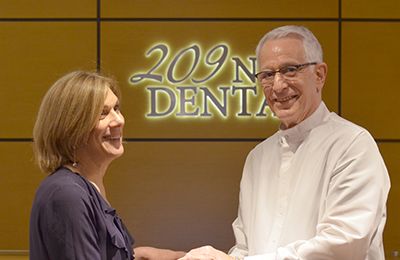 Free Consultation
Free Consultation
 Complimentary Teeth Whitening
Complimentary Teeth Whitening
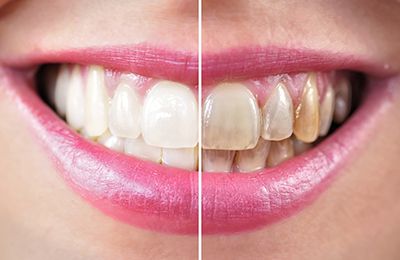 Teeth Whitening
Teeth Whitening
